C++ STL std::list探索
Overview
本文主要是侯捷《STL与泛型编程》课程关于
std::list
容器的学习笔记,此外,在课程的基础上做了一些简单的验证和实验,加深了对
std::list
对象内存布局的理解。本文主要包含以下内容:
-
std::list的变化:从GCC 2.9到GCC 4.9到GCC 13.0 -
std::list的迭代器 - 部分成员函数的实现
- 一个简单的测试实验
std::list in GCC 2.9

GCC 2.9中
std::list
实现比较简单,只有一个Delegation关系,
list
中包含一个
__list_node
类型的指针对象。
可以看到这个实现比较粗糙:
-
__list_node中的指针对象是void*类型,意味着在进行操作的时候会发生类型转换; - 迭代器的定义传递的参数过多,所有需要的类型都通过template传递;
std::list in GCC 4.9

GCC 4.9中
std::list
的设计变得更加符合C++的风格,充分运用了C++的特性,加入继承和多态,使用Composition关系组织各个类。

_List_node
// gcc 11 stl_list.h
/// Common part of a node in the %list.
struct _List_node_base
_List_node_base* _M_next;
_List_node_base* _M_prev;
static void
swap(_List_node_base& __x, _List_node_base& __y) _GLIBCXX_USE_NOEXCEPT;
_M_transfer(_List_node_base* const __first,
_List_node_base* const __last) _GLIBCXX_USE_NOEXCEPT;
_M_reverse() _GLIBCXX_USE_NOEXCEPT;
_M_hook(_List_node_base* const __position) _GLIBCXX_USE_NOEXCEPT;
_M_unhook() _GLIBCXX_USE_NOEXCEPT;
/// An actual node in the %list.
template<typename _Tp>
struct _List_node : public __detail::_List_node_base
#if __cplusplus >= 201103L
__gnu_cxx::__aligned_membuf<_Tp> _M_storage;
_Tp* _M_valptr() { return _M_storage._M_ptr(); }
_Tp const* _M_valptr() const { return _M_storage._M_ptr(); }
#else
_Tp _M_data;
_Tp* _M_valptr() { return std::__addressof(_M_data); }
_Tp const* _M_valptr() const { return std::__addressof(_M_data); }
#endif
_List_iterator
// gcc 11 stl_list.h
* @brief A list::iterator.
* All the functions are op overloads.
template<typename _Tp>
struct _List_iterator
typedef _List_iterator<_Tp>_Self;
typedef _List_node<_Tp>_Node;
typedef ptrdiff_tdifference_type;
typedef std::bidirectional_iterator_tagiterator_category;
typedef _Tpvalue_type;
typedef _Tp*pointer;
typedef _Tp&reference;
_List_iterator() _GLIBCXX_NOEXCEPT
: _M_node() { }
explicit
_List_iterator(__detail::_List_node_base* __x) _GLIBCXX_NOEXCEPT
: _M_node(__x) { }
_Self
_M_const_cast()
const _GLIBCXX_NOEXCEPT
{ return *this; }
// Must downcast from _List_node_base to _List_node to get to value.
_GLIBCXX_NODISCARD
reference
operator*() const _GLIBCXX_NOEXCEPT
{ return *static_cast<_Node*>(_M_node)->_M_valptr(); }
_GLIBCXX_NODISCARD
pointer
operator->() const _GLIBCXX_NOEXCEPT
{ return static_cast<_Node*>(_M_node)->_M_valptr(); }
_Self&
operator++() _GLIBCXX_NOEXCEPT
_M_node = _M_node->_M_next;
return *this;
_Self
operator++(int) _GLIBCXX_NOEXCEPT
_Self __tmp = *this;
_M_node = _M_node->_M_next;
return __tmp;
_Self&
operator--() _GLIBCXX_NOEXCEPT
_M_node = _M_node->_M_prev;
return *this;
_Self
operator--(int) _GLIBCXX_NOEXCEPT
_Self __tmp = *this;
_M_node = _M_node->_M_prev;
return __tmp;
_GLIBCXX_NODISCARD
friend bool
operator==(const _Self& __x, const _Self& __y) _GLIBCXX_NOEXCEPT
{ return __x._M_node == __y._M_node; }
#if __cpp_impl_three_way_comparison < 201907L
_GLIBCXX_NODISCARD
friend bool
operator!=(const _Self& __x, const _Self& __y) _GLIBCXX_NOEXCEPT
{ return __x._M_node != __y._M_node; }
#endif
// The only member points to the %list element.
__detail::_List_node_base* _M_node;
总的来说,迭代器是一个_List_node_base型的指针。每种Containers都含有一个iterator成员,实现了一系列的操作符重载,用于模拟指针操作(vector,array除外,两者的iterator都是pointer iterator)。
operator++()和operator++(int)
// gcc 11 stl_list.h
_Self&
operator++() _GLIBCXX_NOEXCEPT
_M_node = _M_node->_M_next;
return *this;
_Self
operator++(int) _GLIBCXX_NOEXCEPT
_Self __tmp = *this;
_M_node = _M_node->_M_next;
return __tmp;
std::list重载了两个++操作符,这是因为对于++这类单目操作符,可以是++ite或ite++,即有prefix form和postfix form两种形式。
operator++()
这是prefix form,即++ite。我们知道前置自增意味着我们需要先自增在返回,因此prefix form的重载比较简单,直接让当前指向下一个节点再 返回引用 即可。
operator++(int)
这是postfix form,即ite++。我们知道后置自增意味着我们需要返回当前值再进行自增操作,它的实现分为三步:
-
_Self __tmp = *this;:调用 拷贝构造 创建一个临时变量来记录原值,注意这个*this并不会调用operator*()来完成对ite的“解引用”(iterator只是在模拟指针,因此叫解引用并不严谨)。 -
_M_node = _M_node->_M_next;:当前节点指向下一个节点。 -
return __tmp;:返回记录下来的原值,注意这里是return by value而不是prefix form中的return by reference。
operator*()
// gcc 11 stl_list.h
// Must downcast from _List_node_base to _List_node to get to value.
_GLIBCXX_NODISCARD
reference
operator*() const _GLIBCXX_NOEXCEPT
{ return *static_cast<_Node*>(_M_node)->_M_valptr(); }
因为
_M_node
是
_List_node_base
型的指针,当我们想要访问
_M_node->_M_data
的时候,我们需要进行强制类型转换
static_cast<_List_node<_Tp>>(_M_node)->_M_valptr()
。这个设计尚未明晰设计原因。
operator->()
// gcc 11 stl_list.h
_GLIBCXX_NODISCARD
pointer
operator->() const _GLIBCXX_NOEXCEPT
{ return static_cast<_Node*>(_M_node)->_M_valptr(); }
成员函数
push_back()
// gcc 11 stl_list.h
template<typename... _Args>
_M_insert(iterator __position, _Args&&... __args)
_Node* __tmp = _M_create_node(std::forward<_Args>(__args)...); // 创建一个用户申请类型的节点
__tmp->_M_hook(__position._M_node); //
this->_M_inc_size(1); // 哨兵节点计数值+1
push_back(value_type&& __x)
{ this->_M_insert(end(), std::move(__x)); }
这里的
_M_hook
函数是在
_List_node_base
中声明的:
// gcc/libstdc++-v3/src/c++98/list.cc
_List_node_base::
_M_hook(_List_node_base* const __position) _GLIBCXX_USE_NOEXCEPT
this->_M_next = __position;
this->_M_prev = __position->_M_prev;
__position->_M_prev->_M_next = this;
__position->_M_prev = this;
如果画图分析一下(这里就不画图了),就可以发现_M_hook的作用是将this挂(hook)到 position之前:
-
_M_hook之前:
尾<-->C<-->B<-->A<-->头 -
_M_hook之后:(position指向
end()尾节点)尾<-->新节点<-->C<-->B<-->A<-->头
size()
// gcc 11 stl_list.h
// in class _List_base<_Tp, _Alloc>
#if _GLIBCXX_USE_CXX11_ABI
size_t _M_get_size() const { return _M_impl._M_node._M_size; }
void _M_set_size(size_t __n) { _M_impl._M_node._M_size = __n; }
void _M_inc_size(size_t __n) { _M_impl._M_node._M_size += __n; }
void _M_dec_size(size_t __n) { _M_impl._M_node._M_size -= __n; }
# if !_GLIBCXX_INLINE_VERSION
size_t
_M_distance(const __detail::_List_node_base* __first,
const __detail::_List_node_base* __last) const
{ return _S_distance(__first, __last); }
// return the stored size
size_t _M_node_count() const { return _M_get_size(); }
# endif
#else
#endif
// in class list<_Tp, _Alloc>
#if _GLIBCXX_USE_CXX11_ABI
static size_t
_S_distance(const_iterator __first, const_iterator __last)
{ return std::distance(__first, __last); }
// return the stored size
size_t
_M_node_count() const
{ return this->_M_get_size(); }
#else
#endif
_GLIBCXX_NODISCARD
size_type
size() const _GLIBCXX_NOEXCEPT
{ return _M_node_count(); }
可以看到
size()
的复杂度是O(1)的,直接从
_M_node
中取
_M_size
就好。
begin()/end()/empty()
// gcc 11 stl_list.h
_GLIBCXX_NODISCARD
iterator
begin() _GLIBCXX_NOEXCEPT
{ return iterator(this->_M_impl._M_node._M_next); }
_GLIBCXX_NODISCARD
iterator
end() _GLIBCXX_NOEXCEPT
{ return iterator(&this->_M_impl._M_node); }
_GLIBCXX_NODISCARD bool
empty() const _GLIBCXX_NOEXCEPT
{ return this->_M_impl._M_node._M_next == &this->_M_impl._M_node; }
_M_impl包含的是一个结点对象,而不是一个指针 ,由于哨兵结点指向尾结点,在非空情况下尾节点又指向头节点,所以这几个函数的实现比较简单。
内存布局实验
#include <list>
#include <iostream>
#include <string>
using namespace std;
int main()
list<int> l;
l.push_back(1);
l.push_back(2);
l.push_back(3);
list<int>::iterator it_end = l.end();
list<int>::iterator it_begin = l.begin();
cout << "list address: " << &l << endl;
cout << "list iterator end address: " << &it_end << endl;
cout << "list iterator begin address: " << &it_begin << endl;
cout << "list size: " << sizeof(l) << endl;
cout << "size_t object begin size: " << sizeof(it_begin) << endl;
cout << "list iterator end size: " << sizeof(it_end) << endl;
cout << "list object size: " << sizeof(list<int>) << endl;
return 0;
上述代码分别输出了一个
std::list
对象
l
的地址,以及begin()和end()迭代器地址和大小:

可以看到
l
对象的内存地址是
0x016fdff3e0
,
begin()
迭代器指向的地址是
0x016fdff3b0
,
end()
迭代器指针指向的地址是
0x016fdff3b8
。需要注意的是,
l
的大小是24字节,而不是前文提到的8字节,在GCC 4.9版本中一个
std::lis
t对象仅包含一个
_List_base_node
类型的对象作为
哨兵节点
,其中仅有两个指针
_M_prev
和
_M_next
,侯捷所用的环境是32位OS,所以一个指针4字节,两个指针8字节。而我所用的编译环境是Clang 13.0.0,据资料至少在GCC 5.4之时就修改了哨兵节点的定义:
// gcc 5.4.0 stl_list.h
